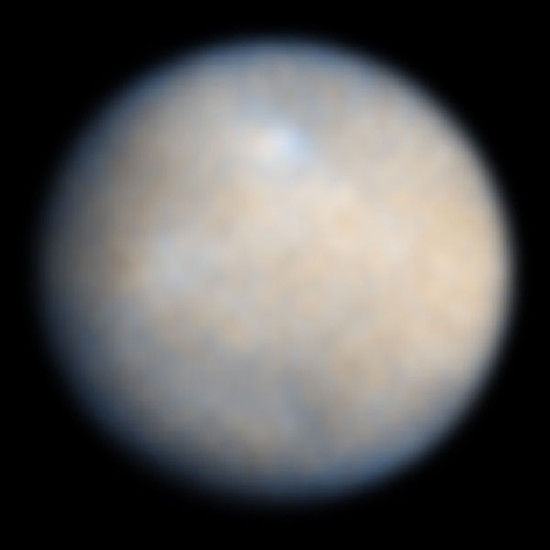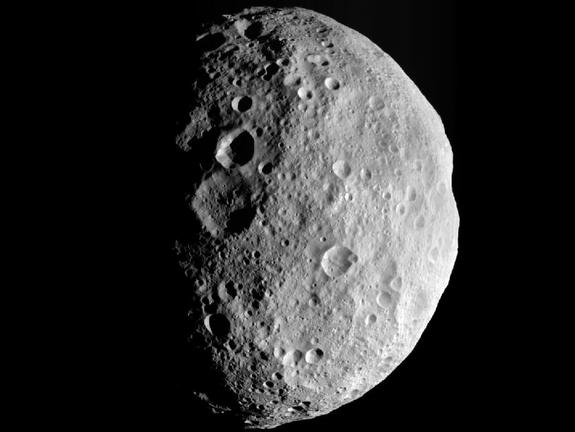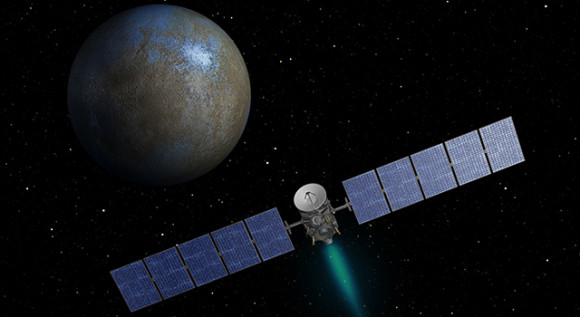December 27, 2013 On this date, NASA says, the Dawn spacecraft is closer to the dwarf planet Ceres – its current destination – than to Vesta, which it spent nearly 14 months orbiting in 2011 and 2012. When it reaches Ceres in 2015, Dawn will become the first spacecraft to go into orbit around two destinations in our solar system beyond Earth.
Why two bodies in the asteroid belt? For one thing, Ceres and Vesta are very different objects. Ceres presents an icy – possibly watery – while Vesta is dry. These two bodies are thought to be two of the largest surviving protoplanets — bodies that almost became planets. The study of both Vesta and Ceres is expected to give scientists clues about the planet-forming conditions at the dawn of our solar system.
In September 2012, Dawn left Vesta and has been cruising toward Ceres ever since. It’s due to arrive approximately one year from now, in late March or early April 2015.
Ceres – now labeled as a dwarf planet by the International Astronomical Union – is the largest member of the asteroid belt between Mars and Jupiter. Vesta is the second-most-massive object in the main asteroid belt


Discovered in 1801, Ceres is approximately 590 miles (950 km) across. Its round shape suggests that its interior is layered like those of terrestrial planets such as Earth. Ceres may have a rocky inner core, an icy mantle, and a thin, dusty outer crust. These characteristics have been inferred from its density and rotation rate of 9 hours.
Dawn will be the first spacecraft to see Ceres up close.
Bob Mase, Dawn’s project manager at NASA’s Jet Propulsion Laboratory, Pasadena, California, said in a press release earlier this month:
Our flight plan around Ceres will be choreographed to be very similarly to the strategy that we successfully used around Vesta. This approach will build on that and enable scientists to make direct comparisons between these two giants of the asteroid belt.
UCLA’s Christopher Russell, who is Dawn’s principal investigator, said of the December 27, 2013 date – on which Dawn becomes closer to Ceres than Vesta – that the transition from leaving Vesta to approaching Ceres …
… makes us eager to see what secrets Ceres will reveal to us when we get up close to this ancient, giant, icy body. While Ceres is a lot bigger than the candidate asteroids that NASA is working on sending humans to, many of these smaller bodies are produced by collisions with larger asteroids such as Ceres and Vesta. It is of much interest to determine the nature of small asteroids produced in collisions with Ceres. These might be quite different from the small rocky asteroids associated with Vesta collisions.
Read more about NASA’s planned activities when Dawn reaches Ceres in 2015

Bottom line: On December 27, 2013, NASA’s Dawn spacecraft will be closer to the dwarf planet Ceres than to Vesta, which it orbited in 2011 and 2012. Dawn will reach Ceres in 2015 and become the first spacecraft to arrive at two destinations in our solar system, beyond Earth.











